Army Lists
Regimental Standards and Cap Badges
1 - 10 | 11 - 20
| 21 - 30 | 31 - 40 |
41 - 50
| 1st Battalion
Lincolnshire Regiment |
 |
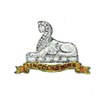 |
|
| Regimental Colour |
Cap Badge Men |
|
The Regimental Colour is of an old pattern, and has recently
been repaired. In the centre is the pre-Territorial number "X"
(for Tenth Foot) with the surrounding inscription "North
Lincolnshire". It may be noticed that the tail of the Sphinx
in the Cap Badge and in the base of the colour is turned up
by its side instead of over its back as is the more usual custom.
The Regimental March is one of the best-known in the British
Army, being the well-known air of "The Lincolnshire Poacher".
|
| 1st Battalion
Devonshire Regiment |
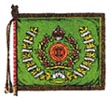 |
 |
|
| Regimental Colour |
Cap Badge |
|
The Regimental Colour of the Battalion is Lincoln green, as
their full dress facings are of that shade. The castle seen
on the colour and in the Badge is the Castle of Exeter. The
motto is "Semper Fidelis" (Ever Faithful). The Regimental
March, "We've lived and we've loved together", and
nickname "The bloody Eleventh", date from Salamanca.
There are 21 Great War Honours borne on the King's Colour. |
| 1st Battalion
Suffolk Regiment |
 |
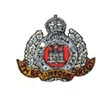 |
|
| Regimental Colour |
Cap Badge |
|
This Regimental Colour is one of the few of the old type still
carried in the Army. With the accompanying Queen's Colour, it
was presented at Weedon in 1849, and though repaired, is in
a marvellous state of preservation. The colour-pike still has
the old spear-head top. The battalion wears the red flash behind
the Cap Badge and, as one of the regiments with "Minden"
as a Battle Honour, on August 1st red and yellow roses are worn
in the headress. In the Great War the Regiment was represented
by no less than 22 battalions. |
| 2nd Battalion
The Bedfordshire and Hertfordshire Regiment |
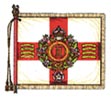 |
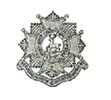 |
|
| Regimental Colour |
Cap Badge |
|
During the Great War the Bedfordshire Regiment mustered 18 battalions,
while the Hertfordshire Regiment, composed of Territorials,
has four. After the Armistice, the title of the Bedfordshires
was changed to "Bedfordshire and Hertfordshire Regiment",
and the Cap Badge was altered in accordance. There are now two
battalions of this Regular regiment, and it also has a Territorial
battalion (the Fifth). The Hertfordshire Regiment still exists
as a Territorial unit. The Regimental Colour illustrated was
presented in 1926. |
| 2nd Battalion
Leicestershire Regiment |
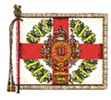 |
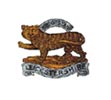 |
|
| Regimental Colour |
Cap Badge |
|
The facings of the Regiment are white, hence the white colour.
It is interesting to note that the Battle Honour for Afghanistan
appears twice, on the left hand side of the colour as "Afghanistan
1839" and on the right "Afghanistan 1878-79".
The Badge of the regiment is known as the "Royal Tiger",
superscribed "Hindoostan", which was granted to it
for its great services in India. On the colour it appears as
green in shade with yellow stripes. The colour illustrated was
presented quite recently. |
| 1st Battalion
The Lancashire Fusiliers |
 |
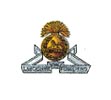 |
|
| King's Colour |
Cap Badge |
|
The Colour of this battalion are old. On the King's Colour,
as can be seen, is the old number of the regiment, which was
formerly the 20th Foot. The Regimental Colour of the 1st Battalion
is yellow, with the Jack in the corner, and on this Jack is
embroidered a rose. In the centre again is the numeral "XX"
surrounded by the inscription "East Devonshire". The
20th Foot fought at Minden and are one of the regiments who
wear the red and yellow roses on Minden Day. |
| 1st Battalion
South Wales Borders |
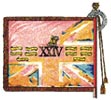 |
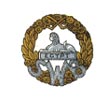 |
|
| The Famous Colour |
Cap Badge |
|
Formerly the 24th Foot, both battalions served in the Zulu War
of 1879. After the disaster at Isandhlwana on Jan 22nd, Lieuts.
Melvill and Cogwhill died to save the Queen's Colour of the
1/24th, which is still carried by that battalion. Queen Victoria
crowned this colour with a wreath or immortelles, later giving
each battalion in memory of their great deeds, a silver wreath
for its Queen's Colour. This is a unique honour: the wreaths
also appear in the Cap Badge. |
| The Royal Inniskilling
Fusiliers |
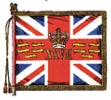 |
 |
|
| King's Colour |
Cap Badge |
|
When the Irish Free State came into existence, the five regiments
which were recruited in that area were disbanded on July 31st
1922. The Royal Inniskilling and Royal Irish Fusiliers, which
belong to the Northern Ireland district, continued to exist,
but each regiment was reduced from two Regular battalions to
one, the two battalions thus formed being linked to form one
Corps. Although a "Royal" Regiment, the Regimental
Colour carried by the Inniskillings - which is as old as the
King's Colour - is buff in shade. |
| 1st Battalion
Gloucestershire Regiment |
 |
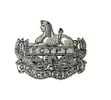 |
|
| Regimental Colour |
Cap Badge |
|
This battalion still carries one of the older types of Regimental
Colour; the 2nd Battalion has the modern white colour with
St George's Cross - the facings being white - and this latter
bearing all the honours thereon, shows more scrolls than any
other Line Regiment. The Badge on the back of the head-dress
commemorates the exploit of the 28th at Alexandra in 1801,
when, assailed in the rear, the rear-rank faced about and
beat off the attack.This Badge was increased in size for another
exploit in the Great War. |
| 2nd Battalion
East Lancashire Regiment |
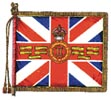 |
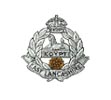 |
|
| King's Colour |
Cap Badge |
|
In the Great Wat, the East Lancashire Regiment numbered 17 battalions,
winning 61 Honours which included 10 elected to be borne on
the King's Colours. The 1st Battalion was the old XXX Foot,
the second being the 59th. The regiment has served all over
the world, some of the Honours on the Regimental Colour being
as far apart as "Cape of Good Hope", "Java",
and "Canton". |
|